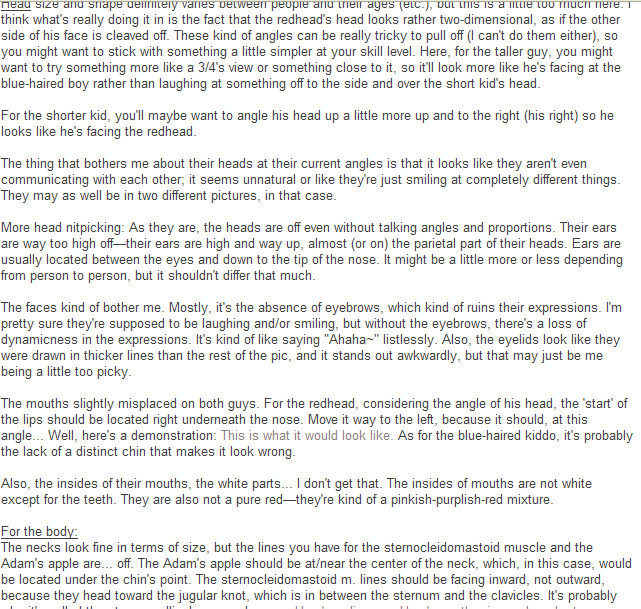 Yahoo~ Third article-type thing for MO!
Yahoo~ Third article-type thing for MO!... C'mon, people, these things shouldn't be so hard to understand that I feel the need to write about it in a blog and link it all over the place.
Let's begin with the basics. The definition of critique is as follows:
–noun
| 1. | an article or essay criticizing a literary or other work; detailed evaluation; review. |
| 2. | a criticism or critical comment on some problem, subject, etc. |
| 3. | the art or practice of criticism. |
| 4. | to review or analyze critically. |
So basically, critiques are critical comments on a piece of work. In our case, the work is a piece of art.
Constructive criticism (or concrit, as it is affectionately known as) in art world is a critical comment that is useful to the artist. It is meant to help a person notice their mistakes and what can be done to fix the mistake or improve the piece.
 Concrit is not a comment that looks like that thing to the left—concrit is not meant to simply express one's opinion or an idea, like a comment. Also, this comment is very rude and just overall bad.
Concrit is not a comment that looks like that thing to the left—concrit is not meant to simply express one's opinion or an idea, like a comment. Also, this comment is very rude and just overall bad. A good critique should look something like this. It isn't perfect and it's on the long side, but it's a decent example of one.
A good critique should look something like this. It isn't perfect and it's on the long side, but it's a decent example of one.One should be critical when critiquing, of course, but do so by picking words that are not hypercritical. Try not to sound condescending as well, so the artist focuses on your advice rather than the need to scream at you for sounding mean, or doesn't lose confidence in themselves. Again, the point is to help, not hurt.
Try to be as clear and concise as possible so the artist can understand your advice. If possible, provide figures or links to further clarify your words. Some people learn differently than others, and some people are better at expressing things in pictures rather than words. In this critique, I used a couple of different links to pictures and redlines to illustrate and straighten out what I meant, since outside of essays, I pretty much write like I would speak.
When critiquing, or heck, even just regular commenting, make an effort to use proper grammar. You don't need to be perfect, just understandable. Chatspeak makes you look ignorant, and no one will take you seriously then. Good spelling is a plus too. FireFox users can use the built-in spell check, y'know.
If there's something you know looks wrong but you can't think of the term for it, either look it up, point it out in a figure, or describe it. If there's jargon that is specific that you'd like to use but isn't something that most everyday people would know, do the same thing. Most kids will probably look confused if you say "sternocleidomastoid", so provide something to clear a specific and uncommon word like that. Toward the bottom of the screencap of the critique up there, I explain the sternocleidomastoid by pointing out what area of the body it is.
Words from Imura:
Let's say you stumble across a picture depicting an oddly proportioned, shakily lined human with inconsistant colouring. Now, knee-jerk reaction for most is to say "OMG U SUCK GO 2 THE DOODLE BOARD." That is a horrible thing to do, because for one, it knocks down the confidence of the artist AND doesn't help him/her improve. Try to avoid comments like that.
An example of a good critique would be:
"I would pay attention to how you do your linework. Using the beizer and straight line tool will make your work much cleaner. Also, remember that using references is a good way to become familiar with the form you're attempting to draw. *insert exact examples of where the proportions are off and how they can be adjusted* The colouring looks good, but there is always room for improvement. Keep in mind shadows/folds/wrinkles/light sources when colouring, and use any tool that you can. That way, you can broaden your abilities and grow as a result. If you'd like me to go into detail about anything I covered, feel free to o-mail me and I'd be happy to explain it."
THAT, my friends, is a critique.
It touches on all the elements the critic thinks need improvement in a conversational and non-condescending tone that offers help instead of highlighting the flaws of a picture. And, if you feel that your advice could be greatly beneficial to the artist, say that you will offer further help at the artist's request. Simply saying "The lineart is shaky and the colouring is bad" is only half the battle.
Typing in complete words will not only make you seem smarter, but will also make reading the critique much easier to the artist. Typing in complete words does not take much more effort than chatspeak.
SUCK IT UP BABIES.
Not only that, but typing complete words gives you an opportunity to practice typing for school. Chatspeak does not go over well with teachers.
Words from Sovern:
The best format I've found is like.. a crit sandwich.
Specific praise, crits, general praise.

No comments:
Post a Comment